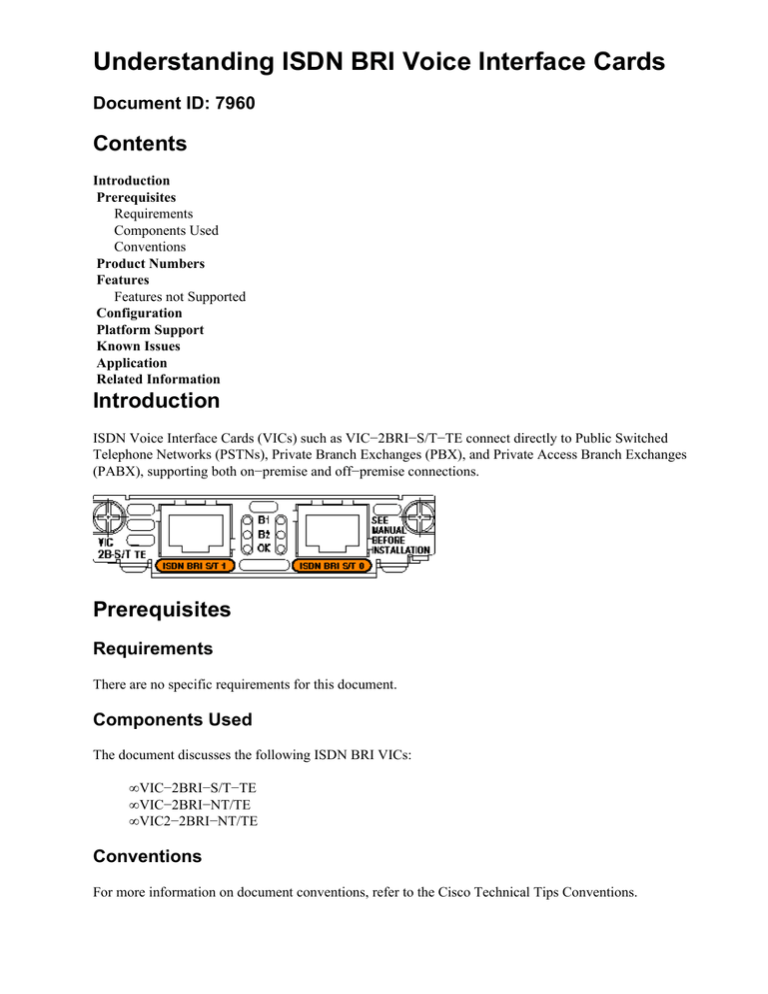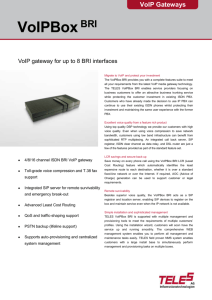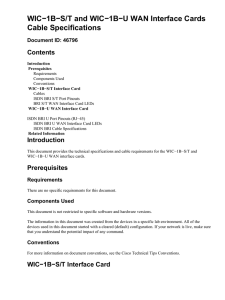
Understanding ISDN BRI Voice Interface Cards
Document ID: 7960
Contents
Introduction
Prerequisites
Requirements
Components Used
Conventions
Product Numbers
Features
Features not Supported
Configuration
Platform Support
Known Issues
Application
Related Information
Introduction
ISDN Voice Interface Cards (VICs) such as VIC−2BRI−S/T−TE connect directly to Public Switched
Telephone Networks (PSTNs), Private Branch Exchanges (PBX), and Private Access Branch Exchanges
(PABX), supporting both on−premise and off−premise connections.
Prerequisites
Requirements
There are no specific requirements for this document.
Components Used
The document discusses the following ISDN BRI VICs:
• VIC−2BRI−S/T−TE
• VIC−2BRI−NT/TE
• VIC2−2BRI−NT/TE
Conventions
For more information on document conventions, refer to the Cisco Technical Tips Conventions.
Product Numbers
Product Number
VIC−2BRI−S/T−TE
VIC−2BRI−NT/TE
Description
Two−port ISDN BRI VIC, S/T interface,
Terminal Equipment (TE)
Two−port ISDN BRI VIC, S/T interface,
Network Termination (NT) or TE
VIC2−2BRI−NT/TE Two−port ISDN BRI VIC, S/T interface,
NT or TE
Features
This table lists the features that are supported on ISDN BRI VICs:
Feature
Voice Ports
ISDN
Interface
Connections
Description
Two ISDN BRI, total of four B channels,
therefore four voice calls per VIC.
ISDN BRI S/T RJ−45
VIC−2BRI−S/T−TEProvides TE ISDN
interface. Connects to the telco central office
switch or a PBX that provides NT. You cannot
connect ISDN phones or faxes to this VIC (it
would require NT implementation).
VIC−2BRI−NT/TEProvides TE or NT.
VIC2−2BRI−NT/TEProvides TE or NT.
Connects as network side or user side to PBX or
key system as off−premises connections (ISDN
voice BRI). Supports patent−pending flexible
Layer 2 (L2) and Layer 3 (L3) configurations.
ISDN Switch
Types
Supports all Cisco IOS® Software ISDN BRI
switch types.
The VIC2−2BRI−NT/TE cards are new generation VICs that are a hardware refresh of the older cards of the
similar functionality, with resolved manufacture component issues. New functionality is also introduced on
these BRI cards (which reduces the number of Stock Keeping Units (SKUs) required).
The VIC2−2BRI−NT/TE is supported on NM−HD−1V, NM−HD−2V, and NM−HD−2VE, where as the
VIC−2BRI−S/T−TE and VIC−2BRI−NT/TE are currently supported on NM−1V/2V.
Features not Supported
This is a list of the features that are not supported on ISDN BRI VICs:
• ISDN supplementary services
• Data calls on the B channels
• Group 4 fax (ISDN digital fax)
• Calls on the ISDN D channel
• When you use the VIC−2BRI−S/T−TE with a NM−1V, you are only able to place two calls. The
second BRI port is shut down.
• When you use the VIC−2BRI−S/T−TE with a NM−2V, you can place four calls. If you have another
VIC in the second slot, the second BRI port on the VIC−2BRI−S/T−TE is shut down.
• The ISDN BRI VICs are only supported for connectivity to another switching system (for example: a
PBX or to the PSTN). Connectivity to ISDN BRI phones is not supported.
Configuration
The ISDN parameters are configured similar to a data ISDN BRI interface.
Note: The isdn incoming−voice modem command is required to route the voice call to the digital signal
processor (DSP) on the Voice Network Module. For additional information on this command, refer to isdn
incoming−voice modem.
For the configuration of voice features in Cisco IOS Software, refer to Voice over IP for the Cisco 3600
Series.
Note: In Cisco IOS Software, issue the voice−port <slot>/<VIC slot>/<unit> global configuration command
in order to configure the voice port parameters.
The commands used to configure VoIP on Cisco routers are very similar on all of the router platforms shown
in this table.
For configuration of voice features in Catalyst OS (CatOS) on a Catalyst 4000, refer to Configuring the Voice
Interfaces.
Platform Support
Cisco IOS Support 1
VIC−2BRI−S/T−TE
2−Port ISDN BRI
VIC, S/T interface,
TE
VIC−2BRI−NT−TE
2−Port ISDN BRI
VIC, S/T interface,
NT, TE
1751, 17603
Not
Supported
2600
2600XM/2650XM
36204, 3640
2
12.0(2)XD, 12.0(3)T,
12.0XK, 12.1(1),
All Cisco IOS
12.1(1)T, 12.2(1),
Software Versions
12.2(2)T,12.2(2)XT,
12.2(11)YT, 12.3(1)
12.1(3)XI,
12.1(5)T,
12.1(5)YB,
12.1(3)XI,
12.2(8)T1,12.2(11)T, 12.1(5)YD,
12.1(5)T,12.1(5)YB,
12.2(11)YT,
12.2(1),
All Versions 12.1(5)YD, 12.2(1),
12.2(12), 12.2(15)ZJ, 12.2(2)T,
12.2(2)T, 12.2(2)XT,
12.3(1), 12.3(2)T
12.2(2)XT,
12.2(11)YT, 12.3(1)
12.2(11)YT,
12.2(15)ZJ,
12.3(1)
3660 2
269
12.0(7)XK,
12.1(1)T,
12.1(5)YB,
12.1(5)YD,
12.2(1),
12.2(2)T,
12.2(2)XT,
All
12.2(11)YT,
12.2(15)ZJ,
12.3(1),
12.3(2)T
12.1(3)XI,
12.1(5)T,
12.1(5)YB,
12.1(5)YD,
12.2(1),
12.2(2)T,
12.2(2)XT,
12.2(11)YT,
12.2(15)ZJ,
12.3(1)
12.2
12.2
12.2
12.3
12.3
12.3
VIC2−2BRI−NT−TE
2−Port ISDN BRI
12.2(15)ZL,
12.2(15)ZJ,
VIC, S/T interface,
12.3(2)XA,
12.3(4)T
NT, TE
12.3(2)XC,
(Not
12.2(15)ZJ,
Not Supported
12.2(15)ZJ, 12.3(4)T
12.3(2)XE,
supported
12.3(4)T
12.3(4)T,
for Cisco
12.3(5)
3620.4)
1
Voice requires a Cisco IOS Software Voice feature set on the 1700 series router, and a Cisco IOS Software
Plus feature set on the 2600/3600 series router.
2
Voice is not supported on the 3631 router.
3
Cisco 1750 router platforms do not support the BRI VICs.
4
Cisco 3620 series routers do not support the VIC2−2BRI−NT−TE cards.
Known Issues
Some of the known issues with the BRI VICs are discussed in this section.
When the BRI voice interfaces are configured, this error message is received:
%C542−1−INSUFFICIENT_DSPS: VNM(1), cannot support all voice channels on VICs.
This is because the VIC−2BRI−S/T−TE can have more B channels than the Voice Network Module can
handle. The NM−1V can handle two voice calls (has two DSPs). The NM−2V can handle four voice calls
(four DSPs). For more information on this, refer to the error message %C542−1−INSUFFICIENT_DSPS
(registered customers only) in the Error Message Decoder (registered customers only)
Another known problem is due to Cisco bug ID CSCdv00152 (registered customers only) .
The compand−type a−law command does not exist on the CLI for a BRI port.
This bug restricted the use of the BRI−VIC to North America, as it resulted in the wrong compand decoding
being applied and caused distorted voice. It was introduced in Cisco IOS Software Releases12.2(2) and
12.2(3)T, and corrected in the 12.2(5) and 12.2(8)T releases.
Application
One of the applications of the BRI VICs is shown in this example. Observe that the BRI VIC can be directly
connected to the PSTN or the ISDN PBX.
12.2
12.3
12.3
Note: The Cisco IOS software releases provided are typically the minimum version required to support the
platform, module, or feature in question. To find out a complete list of Cisco IOS Software releases a feature,
module, interface card, or chassis is supported in, refer to the Software Advisor (registered customers only)
tool.
Note: Refer to the Command Lookup Tool (registered customers only) for more information on the
commands given in this document.
Related Information
• Configuring an ISDN BRI NT/TE Interface on Voice Interface Cards and ISDN BRI Voice
Modules
• Configuring Network Side ISDN BRI Voice Interface Cards
• Using the show isdn status Command for BRI Troubleshooting
• Voice Technology Support
• Voice and Unified Communications Product Support
• Troubleshooting Cisco IP Telephony
• Technical Support & Documentation − Cisco Systems
Contacts & Feedback | Help | Site Map
© 2014 − 2015 Cisco Systems, Inc. All rights reserved. Terms & Conditions | Privacy Statement | Cookie Policy | Trademarks of
Cisco Systems, Inc.
Updated: Jun 16, 2005
Document ID: 7960



